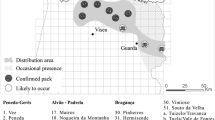Abstract
The dynamics of wolf attacks on domestic ungulates at the levels of population group (the region of Central Forest Nature Reserve) and population (Tver oblast) have been analyzed over the period of 1971 to 2015. It has been found that the frequency of attacks increases during the phase of predator population growth under the effect of qualitative changes within the population. An increase in the frequency of attacks and the number of sheep and calves killed per attack also takes place in the summer–autumn period, as a consequence of training wolf cubs in methods of killing prey. Therefore, domestic animals are not only a source of food for the wolf but also an object for training the young.
Similar content being viewed by others
References
Beschta, R.L. and Ripple, W.J., Wolves, trophic cascades, and rivers in the Olympic National Park, USA, Ecohydrology, 2008, no. 1, pp. 118–130.
Beschta, R.L. and Ripple, W.J., Large predators and trophic cascades in terrestrial ecosystems of the western United States, Biol. Conserv., 2009, vol. 142, no. 11, pp. 2401–2414.
Priklonskii, S.G., Impact of the wolf on domestic animals, in Volk: Proiskhozhdenie, sistematika, morfologiya, ekologiya (The Wolf: Origin, Systematics, Morphology, Ecology), Bibikov, D.I., Ed., Moscow: Nauka, 1985, pp. 374–377.
Treves, A., Jurewicz, R.R., Naughton-Treves, L., et al., Wolf depredation on domestic animals in Wisconsin, 1976–2000, Wildl. Soc. Bull., 2002, vol. 30, no. 1, pp. 231–241.
Gazzola, A., Capitani, C., Mattioli, L., and Apollonio, M., Livestock damage and wolf presence, J. Zool., 2008, no. 274, pp. 261–269.
Kochetkov, V.V., Dynamics and structure of developing wolf population under anthropogenic pressure: Features and patterns, Biol. Bull. (Moscow), 2007, vol. 34, no. 2, pp. 185–193.
Kochetkov, V.V., Biology of the wolf in the Upper Volga region (the example of the Central Forest Nature Reserve), Extended Abstract of Cand. Sci. (Biol.) Dissertation, Moscow, 1988.
Bibikov, D.I., Kudaktin, A.N., and Ryabov, L.S., Synanthropic wolves: Distribution and ecology, Zool. Zh., 1985, vol. 64, no. 3, pp. 429–441.
Rukovskii, N.N., Feeding, in Volk: Proiskhozhdenie, sistematika, morfologiya, ekologiya (The Wolf: Origin, Systematics, Morphology, Ecology), Bibikov, D.I., Ed., Moscow: Nauka, 1985, pp. 325–336.
Ryabov, L.S., Volki Chernozem’ya (Wolves in the Chernozem Zone), Voronezh: Voronezh. Gos. Univ., 1993.
Bologov, V.P., The behavior of wolves during attacks on domestic animals and prevention of damage to livestock husbandry, in Povedenie volka: Sb. nauch. tr. (The Behavior of the Wolf: Collected Scientific Papers), Moscow: Inst. Evol. Morfol. Anim. Ekol. Akad. Nauk SSSR, 1980, pp. 147–157.
Rusakov, O.S. and Timofeeva, E.K., Kaban (The Wild Boar), Leningrad: Leningr. Gos. Univ., 1984.
Filonov, K.P., Los’ (The Moose), Moscow: Lesnaya Promyshlennost’, 1983.
Manteifel, B.P., Ekologiya povedeniya zhivotnykh (The Ecology of Animal Behavior), Moscow: Nauka, 1980.
Vishnevskii, Yu.N., Some features of the winter ecology of wolves in the Mologa–Sheksna lowland, in Ekologiya, okhrana i ispol’zovanie khishchnykh mlekopitayushchikh v RSFSR: Sb. nauch. tr. TsNIL Glavokhoty RSFSR (Predatory Mammals in the Russian Federation: Ecology, Protection, and Utilization. Collected Papers of the Central Research Laboratory, RF Chef Administration for Hunting and Nature Reserves), Moscow, 1982, pp. 73–80.
Belyanin, V.N., Wolves in the Zhiguli Upland, in Ekologicheskie osnovy okhrany i ratsional’nogo ispol’zovaniya khishchnykh mlekopitayushchikh: Mat-ly vsesoyuznogo soveshch. (Ecological Principles of Protection and Rational Management of Predatory Mammals: Proc. All-Union Conf.), Moscow: Nauka, 1979, pp. 86–87.
Author information
Authors and Affiliations
Corresponding author
Additional information
Original Russian Text © V.V. Kochetkov, 2018, published in Ekologiya, 2018, No. 2, pp. 137–145.
Rights and permissions
About this article
Cite this article
Kochetkov, V.V. New Aspect in Understanding the Biocenotic Role of Domestic Ungulates in the Life of Wolf (Canis lupus L.). Russ J Ecol 49, 152–159 (2018). https://doi.org/10.1134/S1067413618020078
Received:
Published:
Issue Date:
DOI: https://doi.org/10.1134/S1067413618020078




